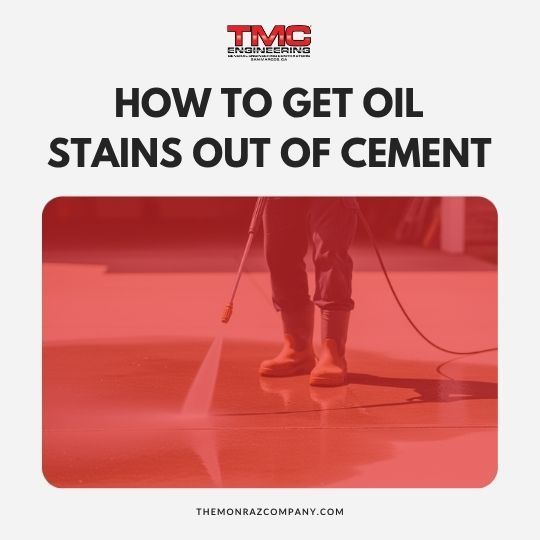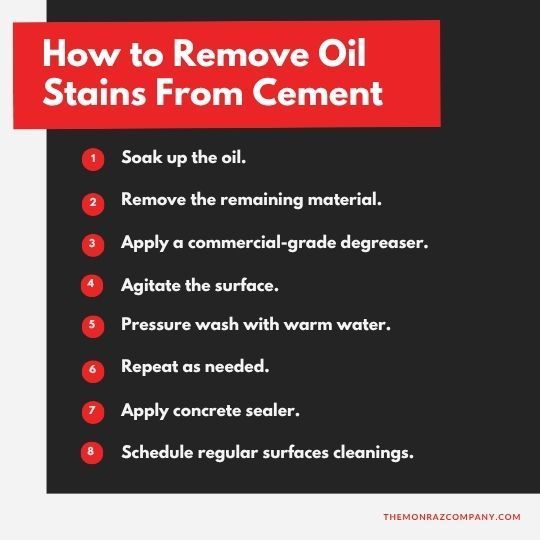How to Get Oil Stains Out of Cement: Commercial Cleaning Tips
Functional parking lots are essential for maintaining a professional appearance in commercial or industrial properties. They provide access, organize traffic, and ensure safe movement for employees, customers, and deliveries.
Proper upkeep of concrete surfaces, however, involves many tasks, including repainting parking lines and repairing cracks, filling potholes, addressing drainage issues, and removing oil stains. While oil stain removal may seem purely cosmetic, appearance isn’t the only reason to clean cement surfaces.
Oil can make pavement slippery for pedestrians and seep deep into the concrete, weakening the structure over time. Additionally, this could increase the risk of cracking or spalling, resulting in costly repairs. Therefore, in this post, we will discuss the best methods for removing oil stains from cement. In commercial settings, prompt attention prevents structural damage and protects the business’s professional image.
For those in Southern California looking to hire professionals, contact the
experts at TMC Engineering. Our team can completely remove existing oil stains and apply a high-quality concrete sealer to protect your surfaces from future blemishes. With professional cleaning and sealing, your concrete will stay stronger, safer, and looking its best for years to come.

How to Get Oil Stains Out of Cement: Commercial Cleaning Tips
Oil residue is notoriously difficult to remove from any surface—cement included. More specifically, removing oil from concrete requires the proper products and techniques to successfully lift the stain without damaging the surface below. In this post, we will explore various methods for effectively fading oil spots. Additionally, we will share expert tips to help you protect your concrete surfaces in the future.
Here’s what you need to know:
Does Motor Oil Stain Cement?
Yes. It’s not uncommon to see oil stains on concrete floors, driveways, and parking lots, especially in areas with heavy vehicle traffic. Concrete is particularly prone to staining because it’s porous and contains calcium compounds that bond with the hydrocarbons in oil. The longer oil sits, the deeper it penetrates and the more it bonds with the surface. This results in dark, glossy patches that stand out from the surrounding concrete.

What Gets Oil Stains from Concrete?
- Dish Soap
- Vinegar
- WD-40
- Industrial Concrete Degreaser
- Trisodium Phosphate (TSP)
- Acetone or Solvent-Based Poultice
- Pressure Washer

How to Remove Oil Stains from Cement
Step One: Soak up the oil.
If the oil is fresh and still pooled on the surface rather than absorbed into the porous concrete, soak it up using kitty litter, sawdust, or baking soda. Let it sit for a few hours if possible. Doing so allows the materials to draw excess oil out of the cement, making it much easier to clean.
Step Two: Remove the remaining material.
After several hours, dispose of the saturated cat litter or other absorbent material. You can do this by vacuuming it with a wet-dry vacuum (like a ShopVac) or sweeping it into a dustpan for disposal.
Step Three: Apply a commercial-grade degreaser.
Now that you have removed the excess oil, tackle the remaining stain. Use a commercial-grade degreaser and follow the manufacturer’s instructions for dilution and application.
Industrial degreasers, such as Zep Industrial Purple Degreaser, Simply Green Pro HD, or Purple Powder work well. For smaller jobs, household degreasers such as dish soap or laundry detergent can be effective.
Step Four: Agitate the surface.
Once the degreaser is applied, use a stiff-bristled brush (for outdoor use) or rotary floor scrubber (for indoor use) to work the product into the concrete. Cement is extremely porous—thorough coverage is key to lifting the stain completely.
Step Five: Pressure wash with warm water.
Assuming the stain is outdoors, finish the job by rinsing it with a pressure washer. Hot water between 180 and 200°F is most effective for lifting any remaining oil and degreaser. Continue pressure washing for several minutes to ensure all residue is removed, leaving the concrete clean and ready for use.
Step Six: Repeat as needed.
If the stain is still present when you finish using the degreaser, brush, and power washer, simply repeat the process. Set-in stains can be extremely arduous to remove. In such cases, call the professionals at TMC Engineering or continue working on the stain until you achieve the desired result.
Step Seven: Apply concrete sealer.
Once the stain’s removed, it’s wise to hire a trusted contractor, like TMC Engineering, to apply a concrete sealer. Concrete sealers provide a protective coating that helps prevent damage from water, chemicals, oil, and other stains. The result is a clean, strong, and lost-lasting surface.
Sealers work by penetrating the concrete and forming a thin, protective topcoat on the cement. This makes the surface less porous, so the concrete doesn’t absorb as much material and is easier to clean in the future. That said, there are several types of concrete sealers, and choosing the right one is crucial.
For outdoor surfaces, such as concrete driveways and parking lots, contractors typically recommend penetrating sealers. These soak into the concrete to provide long-lasting protection against weather, oil, and other contaminants. For indoor concrete, like basement or garage floors, film-forming sealers are commonly used. This option creates a durable topcoat that resists spills and staining while maintaining a smooth finish.
Applying a sealer is a proactive step that protects your investment, extends the life of your concrete, and reduces the effort required for ongoing maintenance. Here’s more on how to maintain your parking lot through seal coating.
Step Eight: Schedule regular surface cleanings.
Oil leaks and other stains are inevitable on any high-traffic surface. To keep your concrete surface clean and professional, schedule regular cleanings to address potential issues before they become deep-set stains. Apply a concrete sealer or schedule routine surface cleaning to protect heavily used areas like loading zones, parking lots, or drive lanes.
Here’s how to keep your concrete clean:
- Sweep debris: Remove dirt, leaves, and trash at least once a week.
- Rinse the surface: Use a hose or low-pressure washer monthly to clear dust and light grime.
- Spot clean stains: Treat oil, grease, or other spills as soon as they occur to prevent deep penetration.
- Scrub high-traffic areas: Focus on walkways, entrances, and parking lanes weekly or biweekly, depending on usage.
- Deep clean periodically: Use a degreaser or pressure washer every 3–6 months, or as needed when stubborn stains appear.
- Inspect and maintain: Check for cracks, potholes, or drainage issues quarterly and repair minor damage promptly.
- Protect with sealer: Apply or reapply a concrete sealer every 2–3 years, or sooner for heavily used surfaces.
Remove oil stains from concrete with an industrial degreaser and agitation.
Even the most carefully maintained commercial concrete surfaces will encounter oil stains over time. The key is not just removing them, but taking steps to protect and preserve the integrity of your pavement. With the right techniques, routine maintenance, and professional guidance, you can keep your concrete looking clean, safe, and functional for years to come.
When you want results done right the first time, the team at TMC Engineering has the experience and expertise to handle oil stain removal, sealing, and ongoing concrete care for your commercial property. Learn more about our services and receive your free quote today.




